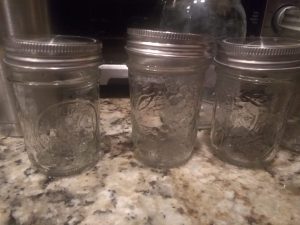Florida is home to the native Muscadine grape (Vitus rotundifolia) which naturally grows in disturbed sites as well as local ecosystems including the marginal areas of wetlands. This native grape provides shelter and food to birds, insects and small mammals. The vines are woody with tender leaves and clusters which bear a dark purple fruit in mid to late summer. Several varieties have been developed for commercial use and backyard fruit cultivation.

I planted my muscadine “Polyanna” grape vine three years ago in a sunny location with a trellis near a fence. I started with a 3-gallon pot and now have a vine that engulfed the original trellis and is in the process of swallowing a 12-foot section of my fence. This was the first year that I was able to harvest a significant number of fruit before the neighborhood birds raided the clusters.
I harvested 8 pounds of fresh fruit from my vine (probably one or two more didn’t make it to the bucket, since I had children helping to pick). The destination for this fruit? The jelly jar.

Jelly-making Process
- I started the process of producing jelly from my muscadines by washing and sorting the fruit. It is important to minimize the number of green unripe grapes that make it into the jelly pot.
- After washing, I added them with just enough water to float to a large enameled soup pot. I wanted something with high sides to avoid the splatter.
- I boiled the grapes and mashed them for about 15 minutes.
- After boiling, I gathered cheesecloth into a layers and poured the smashed grapes and water into the cheesecloth and tied the ends.
- I then hung the cheesecloth above a large container to drain for about an hour. (It needed some extra squeezing.)
- Once my grape mash was done draining, I followed a typical jelly recipe (cutting the sugar by 1/3 and adding lime juice).
- I put my jelly in jars and canned in a water bath (see these instructions for canning).
Bonus, they are easy to grow!
Muscadine grapes are pest resistant and require few, if any, additional fertilizers. Trim back the vines once a year to maintain a desired shape and size and you will soon be harvesting your own delicious bunches of grapes.
See this article for more information.
 1
1

